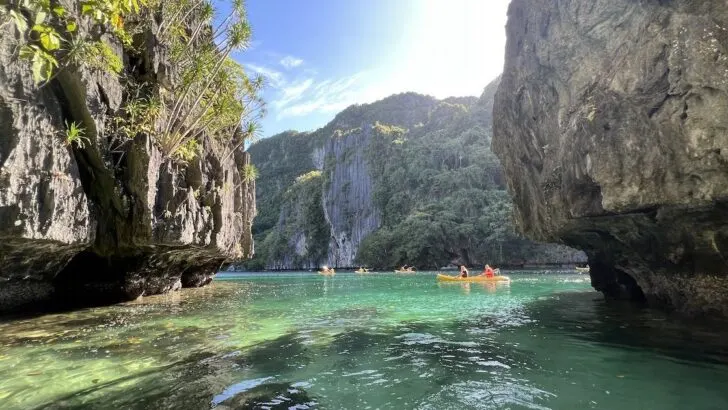If you’re scratching your head over which is the best El Nido tour, don’t worry. Everyone who has been island hopping in El Nido has had the same dilemma. “A, B, C or D?” is the first question on everyone’s tongues.
Located in an area in the northern part of the Palawan archipelago in the Philippines, El Nido is renowned for its island hopping tours.
Why? The traditional bangka boats can access huge kart limestone lagoons with emerald water. There are white-sand beaches on almost every island, and most of the time they are backed by towering limestone cliffs or rows of palm trees.
On top of that, the best El Nido island hopping tours often visit fully or partially hidden beaches concealed behind limestone rocks. There are caves, coral reefs, and the list goes on…
To help you decide, I’ve set out exactly what is involved in each island hopping tour in El Nido and the best El Nido tour for every individual (including less-crowded options and luxury tours).
I’ve also explained the difference between the El Nido private and group tours and the benefits of each, as well as practical details on how to prepare for island hopping and where to get lunch.
Where is El Nido?
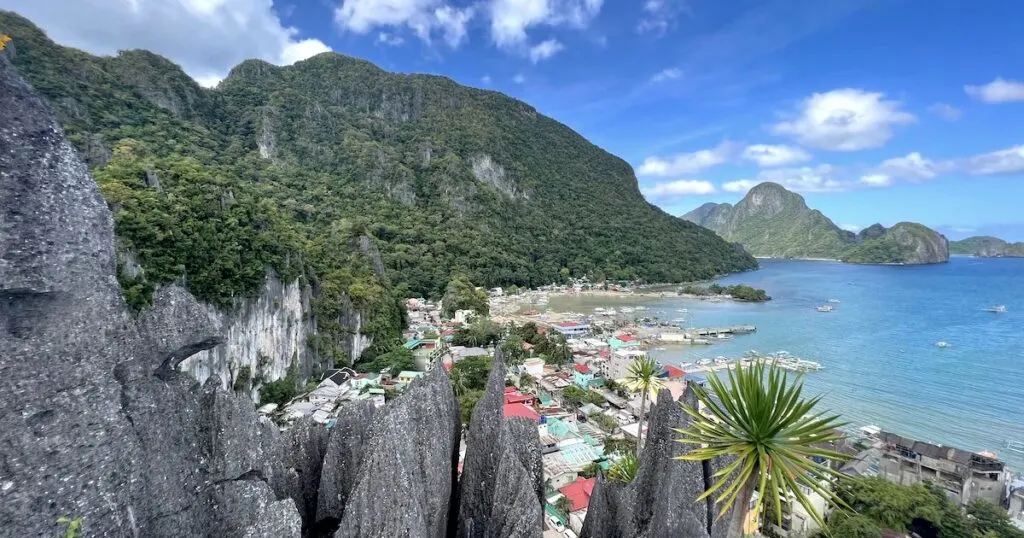
El Nido is an area in the northernmost part of Palawan, an archipelago in the Philippines. It is also the name of El Nido town proper, from which the best El Nido island hopping tours depart.
The town is located in Bacuit Bay, approximately 15 minutes’ drive south of El Nido Airport.
El Nido is a five-hour ferry ride away from Coron, another island popular for island hopping in Palawan – for that, see my guide to the best Coron island hopping tours.
The capital of Palawan, Puerto Princesa (home to the UNESCO World Heritage Site thePuerto Princesa Subterranean Underground River) is a five- or six-hour drive south down the same island.
ESCAPE CHEAT SHEET
Planning your big escape? These are the booking resources I return to time and time again.
Book your hotel or hostel on Booking.com or Hostelworld.
Protect against accidents and emergencies with insurance from Staysure or SafetyWing.
Find a tour or experience on Get Your Guide.
Travel the world for free with TrustedHousesitters.
Is El Nido worth visiting?
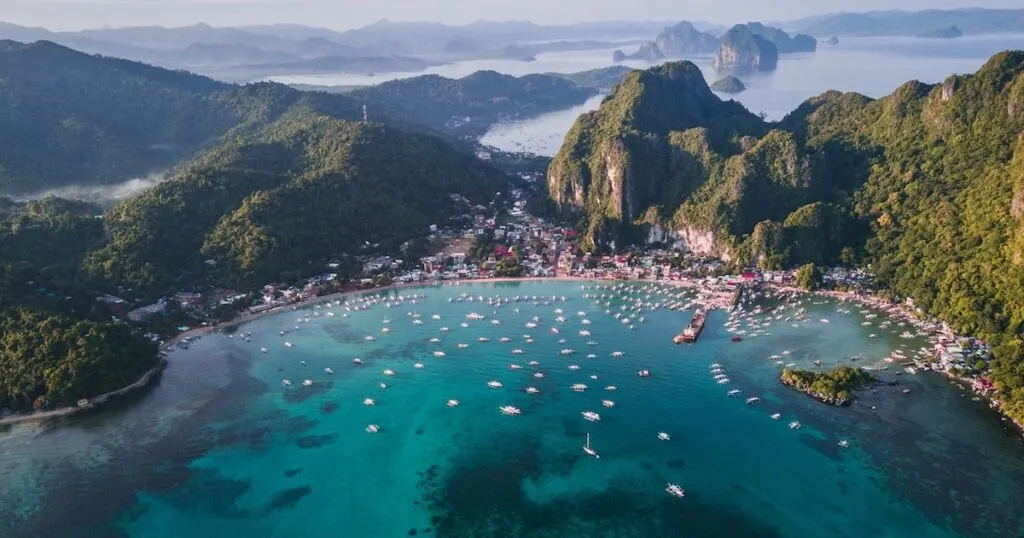
El Nido is the most popular tourist destination in Palawan, without a doubt. Its island hopping tours are immensely impressive.
The islands in El Nido are practically spilling over with stunning landscapes, like lagoons, sandbars, caves, limestone cliffs, hills, and hidden beaches.
There are coral reefs and diving sites too, frequented by turtles, seahorses, nudibranch, reef sharks, and if you’re lucky enough to see them, eagle rays.
It’s not just island hopping that awaits in El Nido, however. The Taraw Cliffs, a series of jagged limestone cliffs which look almost like knives, tower over the town.
In the past few years, locals have built a safe but rickety boardwalk to the cliffs, where there is a viewpoint over the town and bay.
Since I first visited El Nido town in 2018, it has expanded significantly. What was once a small town with just a few accommodation options and one or two go-to bars is now a thriving tourist destination with restaurants and guesthouses by the dozens.
El Nido is also very well-known for its unique island resorts, especially the Cauayan Island Resort and Spa and Matinloc Resort.
How many days is enough for El Nido ?

The best amount of time to spend in El Nido is between three days and one week.
There are four main island hopping tours in El Nido. If you want to give yourself time to do all four tours, you need at least four or five days.
If you only want to do Tour A and Tour C, the two most popular tours, you should visit El Nido for at least two or three days.
The tours run from 8pm to 4pm, taking up eight hours of the day.
Most of them involve vigorous activities such as swimming, snorkelling, and scrambling over rocks. Therefore, you may also need to put aside a day or two to rest and relax, as they can be physically demanding.
If you want to climb the Taraw Cliffs, put aside another full day because the opening times (8am to 5pm) coincide with the timing of the tours.
How to get to El Nido
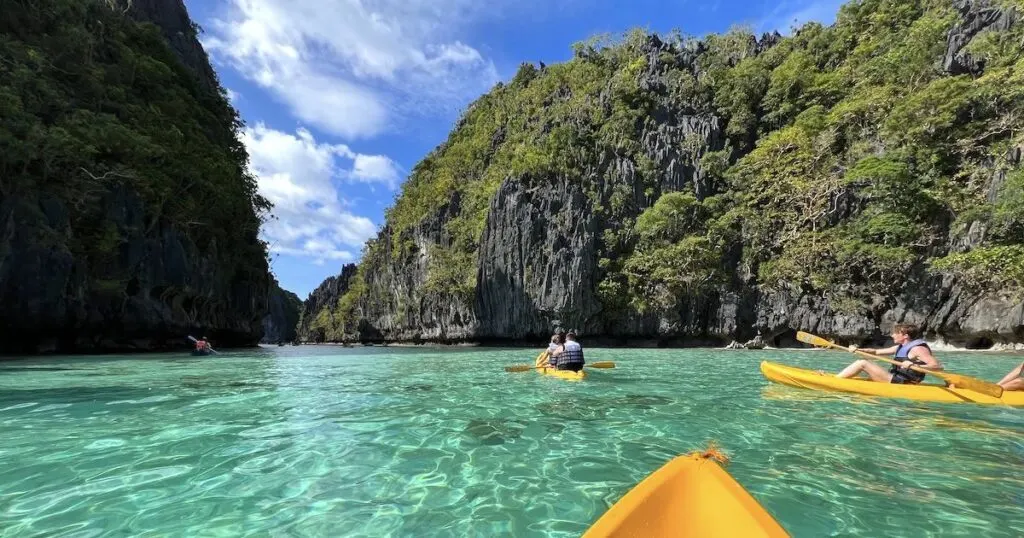
There are several ways to get to El Nido. The best way to get to El Nido depends upon your full plan for travelling Palawan.
Most people start their Palawan itinerary in either Coron or Puerto Princesa.
If they start in Coron, they usually visit Coron, El Nido and Puerto Princesa in that order. If they start in Puerto Princesa, they do the opposite: Puerto Princesa, El Nido, and finally Coron.
Another option is to skip Puerto Princesa entirely, which means you can fly directly to El Nido airport. You won’t get a chance to visit the Puerto Princesa Subterranean River. Your flight will also be more expensive because the cheapest flights in and out of Palawan are from the main airport in Puerto Princesa.
1. How to get to El Nido from Coron
There are two ways to get to El Nido from Coron. The first and quickest method is to take the ferry, which takes approximately four or five hours and costs approximately 2,600 PHP (£35).
This is also the cheapest way.
However, the ferry is notoriously uncomfortable. Most passengers get very sea sick because the crossing has choppy waters. The ferries also leave early at 6am.
The second and more adventurous route is to go island hopping from El Nido to Coron. I have done this twice and count both times as some of my favourite travel experiences in southeast Asia.
Sleeping in handmade wooden huts on remote islands, you’ll spend the days snorkelling over some of Palawan’s best corals, as they haven’t been damaged by hordes of boats and tourists.
It’s also a chance to visit completely uninhabited beaches and islands, as well as the few island-based villages in the area. This area has incredible sunsets and sunrises too.
The tours usually last between three and five days. I have done the tour twice with Tao Philippines, who give back to the island communities by teaching them sustainable farming methods and providing them employment – a good cause. They are, however, expensive in comparison with the ferry.
2. How to get to El Nido from Puerto Princesa
To get to El Nido from Puerto Princesa, you will need to take an air-conditioned minivan transfer between El Nido and Puerto Princesa. There are no local bus services.
The vans are cramped but comfortable. The roads can be windy, so take road sickness tablets.
The journey takes approximately five hours dependent upon traffic and costs approximately 900 PHP (£12).
3. How to get to El Nido by air (from Manila)
There are flights from Manila to El Nido airport, a small airport 15 minutes’ drive from El Nido town proper.
Tricycle taxis can take you to or from the airport. They should cost around 200 PHP (£2.80) one way.
The Best El Nido Tour: The Types Of Tours in El Nido
1. Private island hopping tour in El Nido
A private island hopping tour involves renting a private boat.
The private tours visit routes A, B, C or D, the same destinations covered by the group tours.
The tour is set on a traditional bangka boat, suitable for up to three guests, and the total cost of the tour is split between all three guests.
A private tour is ideal if you want to go island hopping as a family or as a group of friends. You don’t need to feel rushed or crowded. You also have more agency over the itinerary.
For example, you could ask your tour guide to skip one stop in favour of spending longer in a different destination.
2. Group island hopping tour in El Nido
A group island hopping tour is the most budget-friendly tour type in El Nido. They cover routes A, B, C and D.
The group tours accommodate up to 25 people, depending upon the size of the boat. The whole experience is more crowded and noisier.
However, it’s also easier to make friends with other travellers and adds a friendly, sociable atmosphere to the tour.
3. Island hopping by speedboat
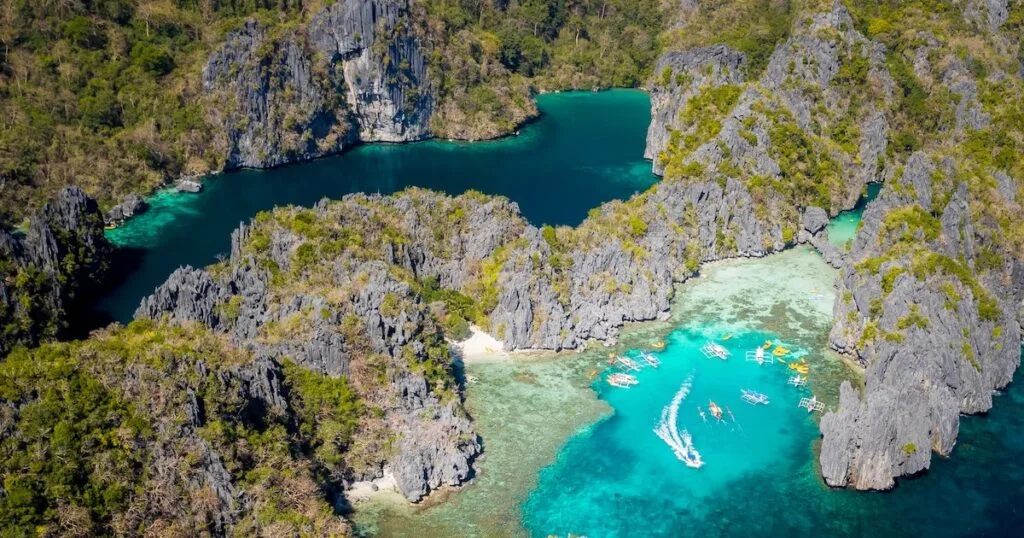
The quickest and most luxurious tours in El Nido are the island hopping tours by yacht or speedboat.
The main benefit of taking a speedboat is that they are quicker, making it possible to beat the crowds to the best attractions. This is the most expensive but equally the most luxurious type of tour.
Most speedboat tours are three to five hours long, meaning that you can make the most of your day back in the town or catch a bus or flight later in the day.
- Premium three-hour speedboat tour of popular routes: Approximately 3500 PHP (£50) per person.
- Private five-hour speedboat tour of Bacuit Bay: 24,700 PHP (£350) for two people.
Entry fees for the El Nido island hopping tours
On top of the raw cost of island hopping in El Nido, you will need to pay an eco-tourism development fee of 200 PHP and entrance fees for the attractions you visit on the tour.
Usually, these are not included in the tour price, but check before you book to be sure.
The El Nido eco-tourism development fee is 200 PHP (£2.80). The fee goes directly towards sustaining the environment and isn’t kept by your tour provider.
Most entry fees, including for Big Lagoon and Small Lagoon, are 200 PHP (£2.80).
They must be paid to your tour guide at the beginning of the trip.
How much does island hopping in El Nido cost?
Island hopping tours can cost up to 17,670 PHP (£250) for a private tour for three people or up to 3500 PHP (£50) for a group tour for one person.
This is once you take into account the additional costs of buying lunch, entry fees, and gear hire.
Let me break it down for you:
A group island hopping tour on its own costs around 2100 PHP (£30) per person.
A private island hopping tour typically costs around 14,200 PHP (£200) for a group of three people. Split between three, this amounts to approximately 4730 PHP (£66) each.
On top of the raw tour costs, a typical day of entry fees will include the 200 PHP (£2.80) eco-tourism development fee and 200 – 400 PHP (£2.80 – £5.60) of entry fees.
For any lagoon tours, you will need to hire a kayak for around 250 PHP (£3.50) and/or a snorkelling mask for 150 PHP (£2).
Lunch is no longer included in the tour price, as of June 30th 2023, so you will also need to account for buying your own packed lunch from one of the restaurants in the town.
This will cost around 200 – 400 PHP (£2.80 – £5.60) for a large budget-friendly meal.
The Best El Nido Tour: How to Prepare for Island Hopping in El Nido
Island hopping El Nido requires some preparation.
1. Choose what to pack and wear for the best El Nido tour
The most important thing you need is a dry bag to protect your belongings from the water.
This can be purchased from market stalls in El Nido town if you don’t have your own.
The second most important thing, in my opinion, are reef shoes. On most of the tours, you will be walking over rocks or sand which might hide sea urchins or lion fish.
Again, sea shoes can be purchased in El Nido town if you don’t have any of your own.
Other items you should pack include:
- A reusable water bottle with water – all plastics are banned on El Nido island tours to protect the environment.
- A quick-dry beach towel.
- Change of clothes.
- Cash – you will need to pay by cash for any extras such as tourist fees, snorkelling or kayaking gear, and food and drinks from kayak vendors.
For a full list of what to wear in Palawan, along with a free packing list and what to wear island hopping, I have a separate guide.
2. Allow time for your journey
The meeting place for most of the best El Nido tours are either on El Nido beach directly next to the town, where the island hopping boats are docked, or at one of the restaurants next to the beach.
It may take you around 20 minutes of walking to reach your meeting place if you’re staying within the town.
If you’re staying on the outskirts of the town or in the Napcan beach area, you may need to account for a tricycle ride to the beach and possible traffic.
Leave plenty of time for breakfast, travel, and finding the meeting point.
Also, don’t skip breakfast. You will need the energy for the day’s activities. Just remember that you’re going to be on a boat all day, and don’t make my mistake of having a huge breakfast before sitting on a stationary boat in the windy bay for half an hour directly afterwards.
What To Expect on the Best El Nido tour
1. An early start
The best El Nido tour will start early to beat the crowds.
Most of the tours depart El Nido Beach before 8:45 AM. Any later, and you may ‘miss the boat’, as the saying goes.
2. A few crowds
El Nido is one of the most crowded destinations in Palawan (and in the Philippines as a whole). Where there’s natural beauty, there are crowds.
If you’re trying to avoid crowds, I’d suggest taking a speedboat tour to beat the crowds to the most popular spots. Tour B and D are also less crowded than Tour A and C.
3. Corals
The coral reefs in El Nido aren’t the best I’ve seen in Palawan. Some of the coral is dead because of over-tourism and unsustainable boating practices. I saw way too many boat anchors buried in the dead coral in El Nido.
There are still some thriving coral gardens, but if you’re looking for slightly more colourful corals and diverse sea life, you can see that island hopping between El Nido or Coron or on an island hopping tour from Coron.
4. No buffet lunch
The buffet lunches were always a well-awaited part of the El Nido tours for me. However, since July 1st 2023 and under the direction of the Mayor of El Nido, meals are no longer included in island hopping tours.
Therefore, you will need to purchase your own meal from the restaurants in the town before going on the tour.
5. Changes of plans
Even on the best El Nido tour, you may need to change your plans.
Entry to attractions like the Big Lagoon are limited to a certain number of people. Tour guides will take you to a different nearby spot if they are turned away.
Sometimes, the schedule doesn’t always run to plan too. For example, I took tour C, excited to visit Matinloc Shrine, but the tour ran out of time and couldn’t stop there.
The Best El Nido Tour: A, B, C or D?
In an ideal world, you’ll have enough time to go on all four El Nido island hopping tours.
However, if you don’t, you will want to make the most of the time you have.
The most popular El Nido tours are Tour A and Tour C. They are also the most crowded.
Tour A is popular because it visits Big Lagoon and Secret Lagoon. Big Lagoon is considered the most impressive destination in El Nido.
Tour C is popular because it visits Hidden Beach and Secret Beach, two fully or partially concealed beaches with an added surprise factor. It also visits Matinloc Shrine, a spiritual site among the islands.
Tour B visits some of the best and less-crowded beaches in El Nido, while Tour D visits pristine beaches and Small Lagoon, a smaller-sized and therefore more intimate lagoon.
Let the following breakdowns help you to choose.
Tour A: The Best El Nido Tour for Kayaking in Limestone Lagoons
Visits:
- Big Lagoon
- Secret Lagoon
- Seven Commandos Beach
- Shimizu Island
- Corong Corong Beach
1. Big Lagoon
Tour A is considered to be the best tour in El Nido by many locals because it is the only tour which visits Big Lagoon, a huge limestone karst lagoon with shallow, green water.
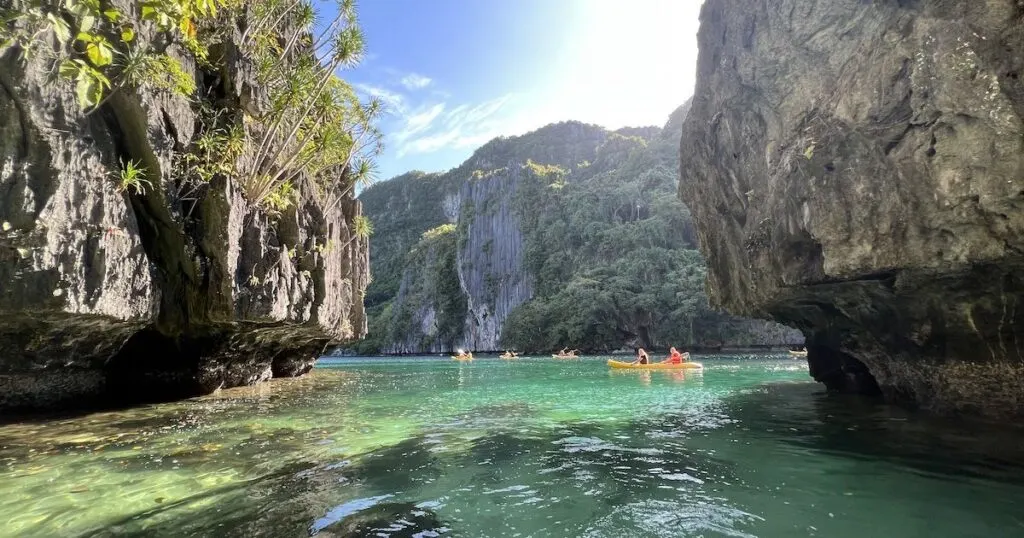
Kayaking through Big Lagoon is a huge bucket-list activity in El Nido, and this is the only route covering the attraction unless you take a speedboat tour.
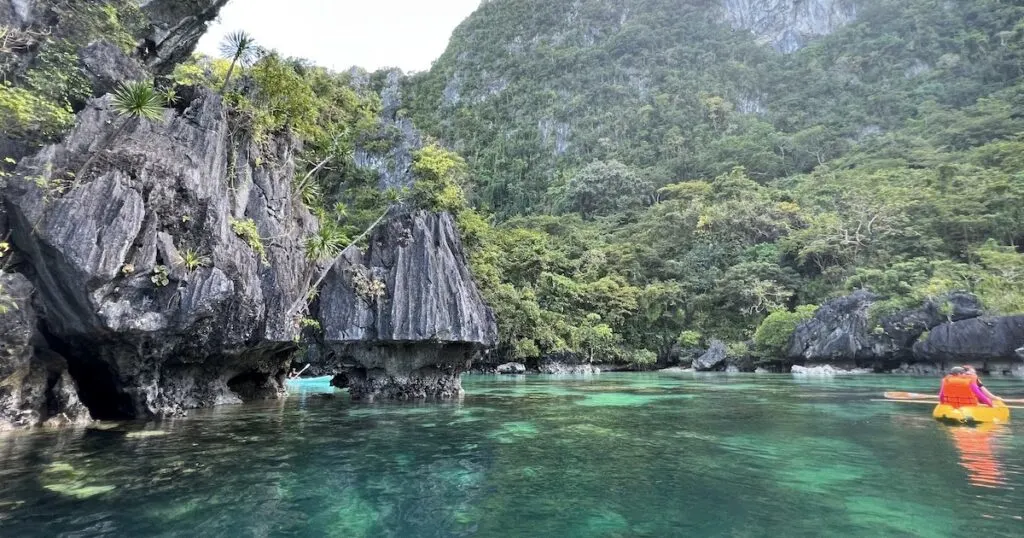
While kayaking through around the lagoon is by far the best part of visiting Big Lagoon, there are also shallow areas of waters (almost like a beach) where you can leave your kayak and float in the shallows.
If you continue kayaking far enough into the lagoon, you’ll also come across areas with reeds and sea urchins.
Round to the left, near the back of the lagoon, you can also find narrow grooves in the rocks just big enough for kayaks to pass through. Ask your guides the way if you can’t find them on your own.
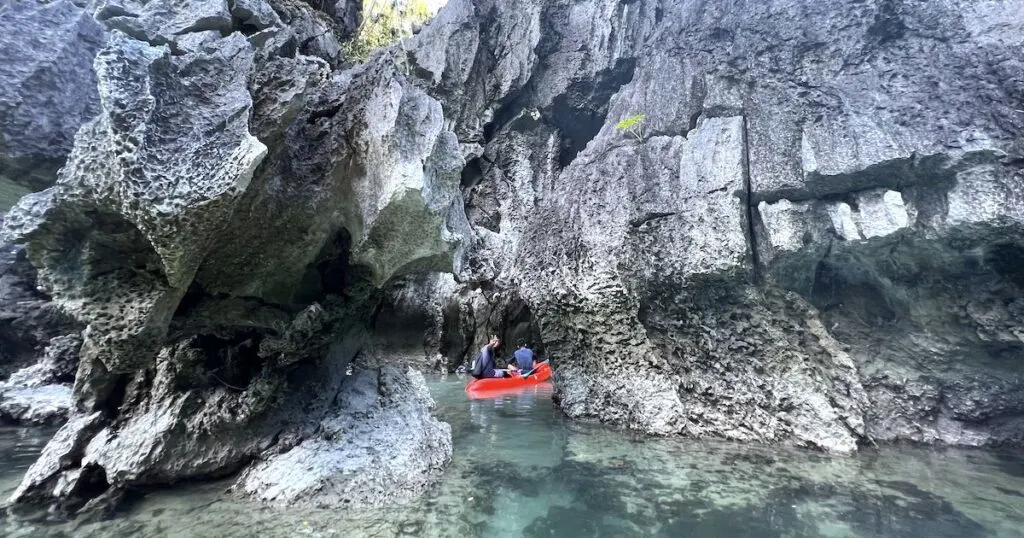
2. Secret Lagoon
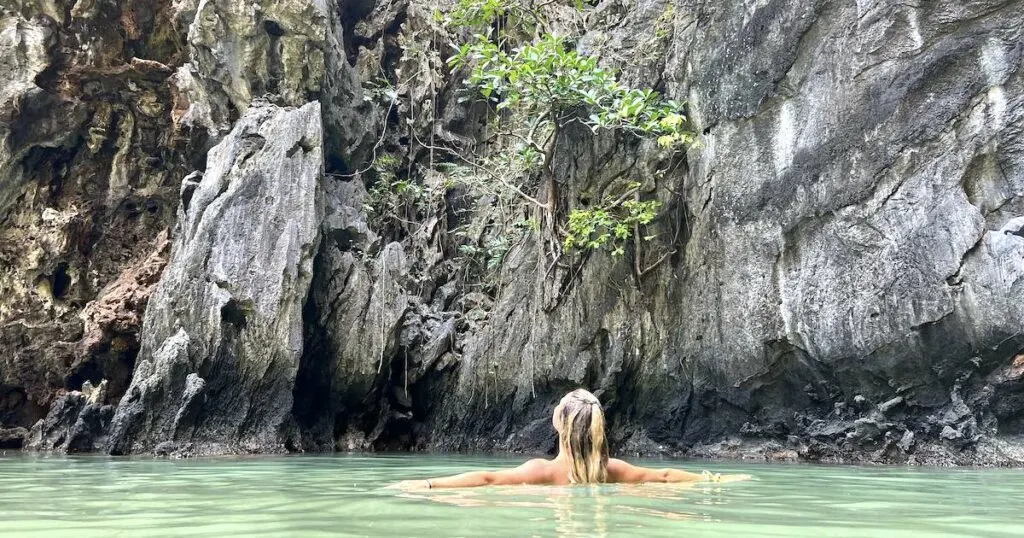
Crawling on all fours through a small cave and emerging into a circular lagoon enclosed by sky-high limestone is bound to be a memorable moment in your Palawan trip.
Secret Lagoon is one of many places in El Nido which is hidden by rocks from the outside
You definitely don’t need a kayak for Secret Lagoon, as it’ll only take you two or three minutes to take a swim around the circumference. The rest of the time you can spend admiring the rockfaces.
3. Seven Commandos Beach
Seven Commandos Beach is one of the closest beaches to El Nido town.
Lined with palm trees and a few swings erected by locals, it is a great place to chill out and snorkel (the corals are on the right-hand side of the beach when you’re facing the ocean).
Seven Commandos Beach got its name from a rumour that seven World War II soldiers became stranded on the beach. Another rumour is that a fishing vessel was stranded on the beach and passengers set up camp there before repairing and sailing their boat away.
The former story is the most popular, because it’s said that locals found a rock carved with ‘Seven Commandos’ on the beach when it was first discovered.
4. Shimizu Island
Shimizu Island is usually the lunch stop on Tour A. The sheer limestone rocks barely make room for the it small, white beaches, and that’s exactly why it’s so beautiful.
Tour B: The Best El Nido Tour for Visiting Less-Crowded Beaches and Caves
Visits:
- Popolkan Island
- Snake Island
- Cudugnon Cave
- Cathedral Cave
- Pinagbuyutan Island
Tour B is a wise choice for anyone who wants to avoid the main tourist crowds. It shows you island hopping as it should be: wild, free, and stunning.
The beaches have some of the most fascinating formations in Palawan, especially Snake Island with its slithery, shifting sandbars.
1. Popolkan Island
Small but sweet, Popolkan Island is one of the most popular snorkelling and diving destinations in El Nido. The great corals are what makes it the first stop on Tour B in El Nido.
2. Snake Island
Snake Island is definitely one of the most impressive islands in El Nido.
The main reason for this is that it has a sandbar, which emerges at low tide only. You can walk the three kilometres along the sandbar to get between the two islands.
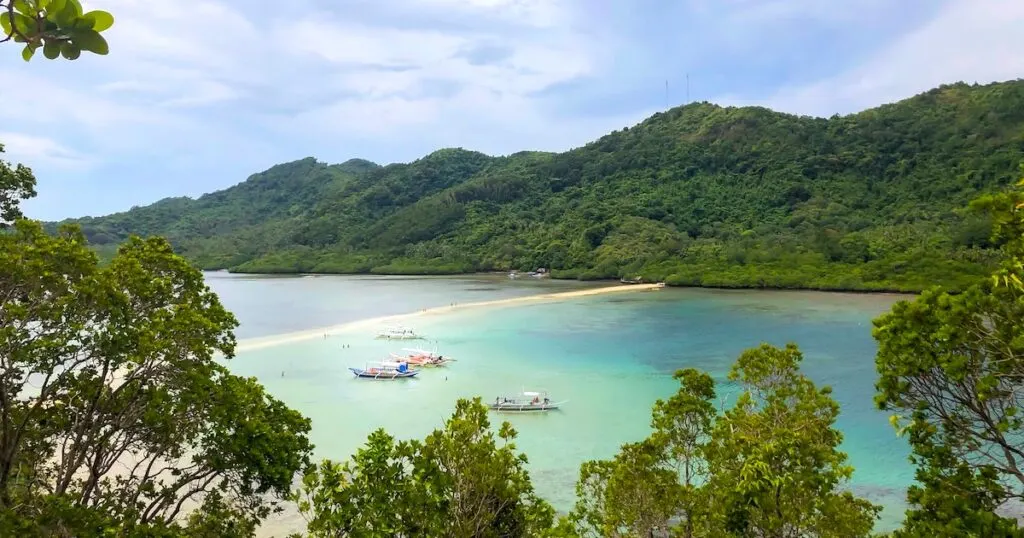
Mangroves and thick palm trees (with the occasional monkey) rest alongside the beach.
If you have enough time, which is more likely on a private tour rather than on a group tour, locals can also show you how to climb to the shed at the top of the island.
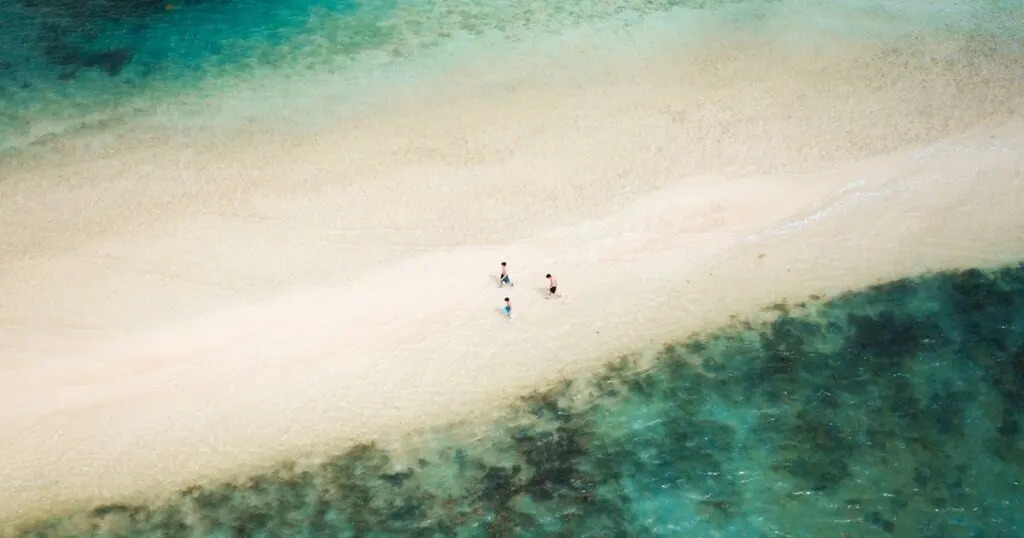
3. Cudugnon Cave
The caves are what really set apart Tour B from the other island hopping tours in El Nido.
Cudugnon Cave is tucked underneath a hill on Lagen Island, miles away from the civilisation of El Nido town. Yet, it still has plenty of history.
The cave is a neolithic burial site for Palawan residents and people who settled in Palawan from Borneo, as part of an ancient practice to return humans to nature. Human bones have been found from as far back as 960 A.D. in the cave.
It’s also thought that Japanese soldiers hid in the cave during the invasion in World War II.
Even without all of the history attached to it, the cave is spectacular, as it is filled with limestone karst formations, stalactites, bats, and swallows. Access to the cave is during low tide only through a small opening.
4. Cathedral Cave
Cathedral Cave earned its name because of its limestone passageway in the shape of a cathedral. Cathedral Cave is more of a drive-by destination rather than anything else, because venomous snakes live inside the cave.
5. Pinagbuyutan Island
Pinagbuyutan Island is one of the closest islands to El Nido town proper, around half an hour’s sailing from the town.
It’s a wild, desolate island, making it an ideal place to relax and snorkel over the beach’s corals without crowds interfering.
Tour C: The Best El Nido Tour for Visiting Secret Beaches
Visits:
- Hidden Beach
- Secret Beach
- Helicopter Island
- Tapiutan Beach
- Matinloc Shrine.
Tour C has the adventure factor every island hopper wants. Discovering secret beaches never gets old, and that’s exactly what makes it one of the best island hopping tours for exploring ‘hidden’ or ‘secret’ spots.
Tour C is very popular, so I can’t say that the beaches are exactly a ‘secret’ anymore. Still, you’d have no idea they were there if it wasn’t for the tour guides.
Matinloc Shrine is also another reason why many like this tour, as the abandoned Virgin Mary shrine is an unusual sight among the miles of deserted islands and limestone rocks.
1. Hidden Beach
On the approach to Hidden Beach, you’ll see nothing but a wall of El Nido limestone. As you get closer, however, you’ll notice a slither of sand through an alley behind one limestone islet.
There couldn’t be a better tropical optical illusion.
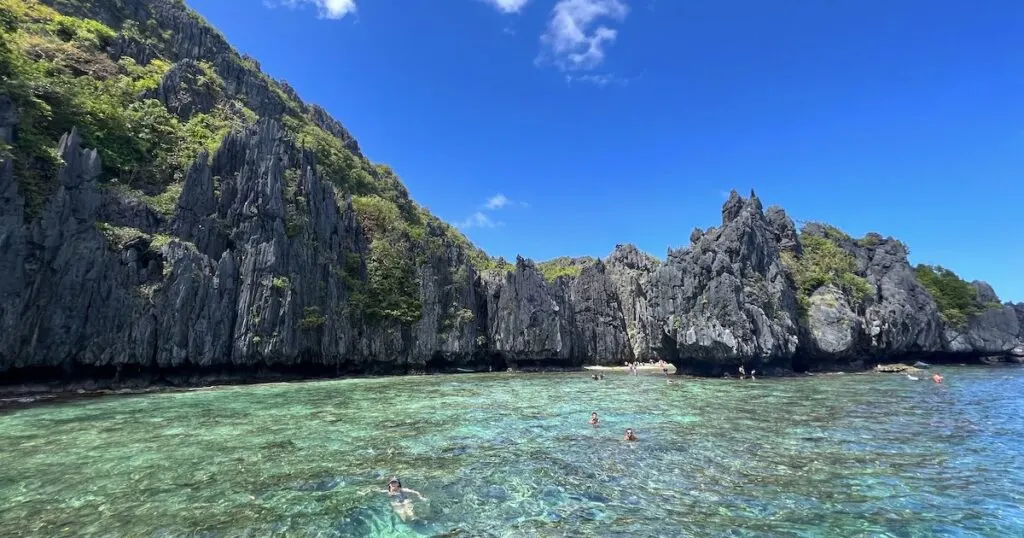
The bangka boats park in the deeper water a distance away from the rocks, as they can’t sail through. Then, you’ll need to clamber over the rocks through knee to thigh-high water to reach the beach.
The clamber is harder than it looks because it’s easy to lose your balance, so hold onto a partner if you can. Reef shoes are an essential.
In the shallow passage of water leading to the main secret beach, I was lucky enough to be joined by a tiny family of tiny reef sharks, who peacefully took a length or two of the water before exiting.
The beach itself is a small trip of white sand, so the most fun part is paddling around the shallow water and spotting marine creatures.
2. Secret Beach
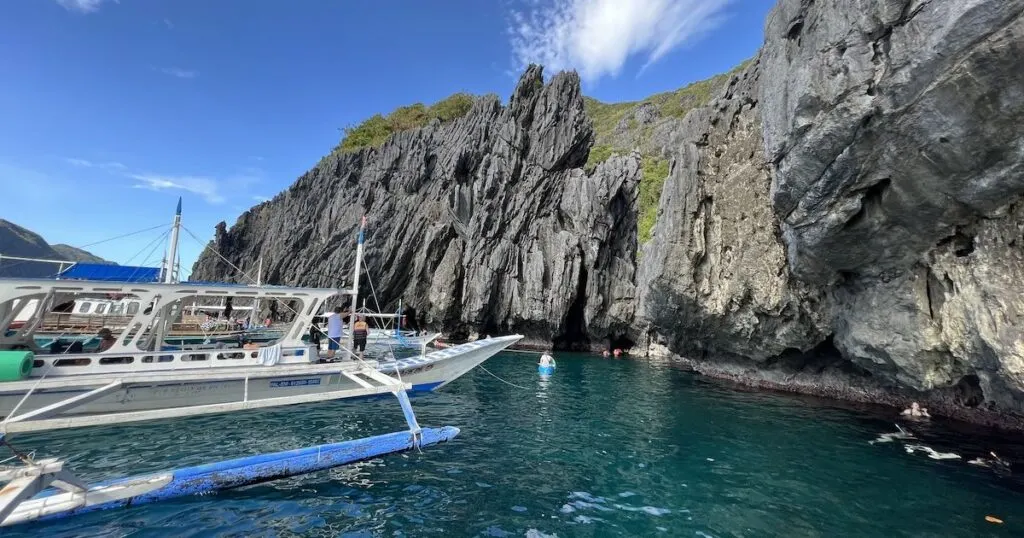
You could say that Secret Beach is Hidden Beach’s more elaborate sibling.
Unlike Hidden Beach, it is fully concealed by limestone rocks and entry is by jumping into deep water and swimming through a narrow passageway into a secret limestone crevice with a beach.
Wear your reef shoes, because once you’ve squeezed through, you still have a small clamber to reach the sand.
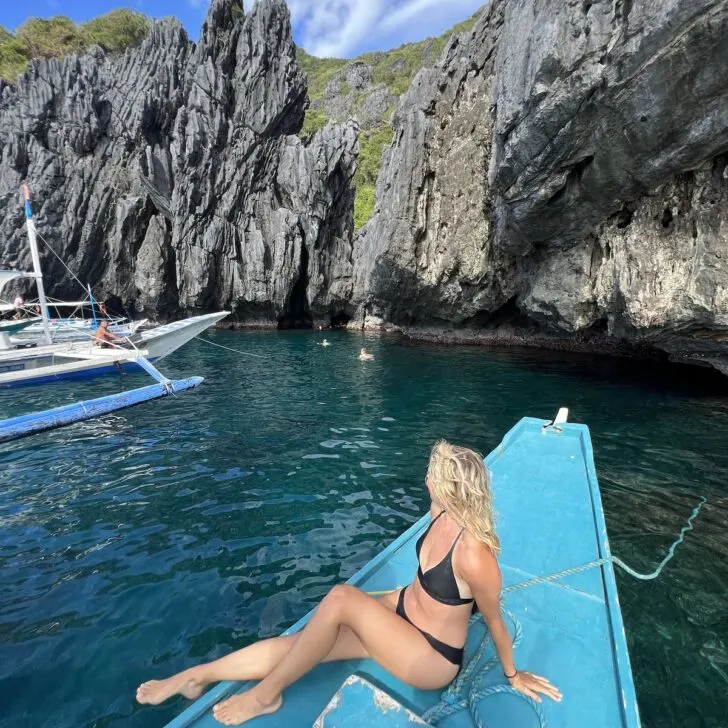
With limestone on all sides, Secret Beach is a special place.
3. Helicopter Island
If you were to fly above Helicopter Island, you’d see why it got its name. Even on the approach, you can tell that the island is shaped vaguely like a helicopter.
Tall, winding and covered in tufts of green, the island has a gorgeous white-sand beach overlooked by towering cliffs.
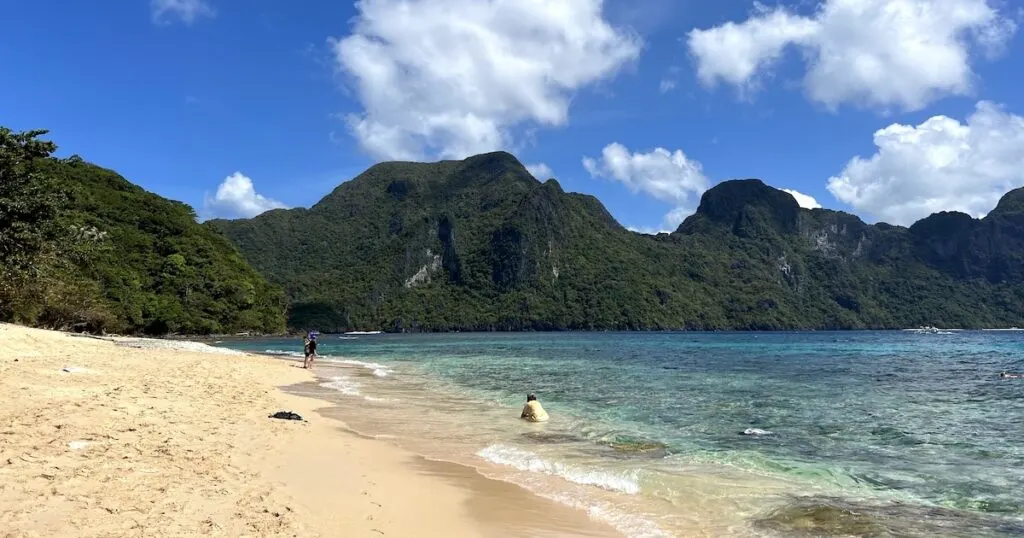
Helicopter Island, in my opinion, was by far the most scenic beach on all of the El Nido island hopping tours.
First thing in the morning, the beach was pretty busy. However, it is still large enough that you can walk until there are no people around. The farthest ends of the beach are mostly deserted.

The beach is also lined with pretty decent corals. You hardly have to go far to find them: just swim a couple of strokes from the beach and you’ll find that the sand very quickly drops down onto a shallow coral reef with lots of rainbow fish.
4. Tapiutan Beach
Positioned alongside Matinloc Island, Tapiutan Beach is a popular stop for lunch, just through a narrow limestone pass and with yet more white sand and corals.
5. Matinloc Shrine
Matinloc Shrine is saved for last. It is a large, white shrine dedicated to Virgin Mary.
It looks rather out of place on Matinloc Island. However, it has been there since 1982, having been supposedly set up by adventurers who found treasure from World War II on the island and built the shrine to cover up their mischievous digging.
The shrine has fell to ruins since they left with their treasures, and a beachfront mansion has met the same fate.
Tour D: The Best El Nido Tour for Snorkelling and Visiting Small Lagoons
Visits:
- Small Lagoon
- Cadlao Island
- Pasandigan Beach
- Nat Nat Beach
- Paradise Beach
- Bukal Island
If want to experience smaller, quieter lagoons typical of El Nido and ‘hidden’ beaches with fewer crowds, this is the tour for you. Its best and first destination is what looks like a miniature version of Big Lagoon.
This is also another of the least-crowded island hopping routes in El Nido, so it’s a tour where you can really tune into the peaceful landscape.
1. Small Lagoon
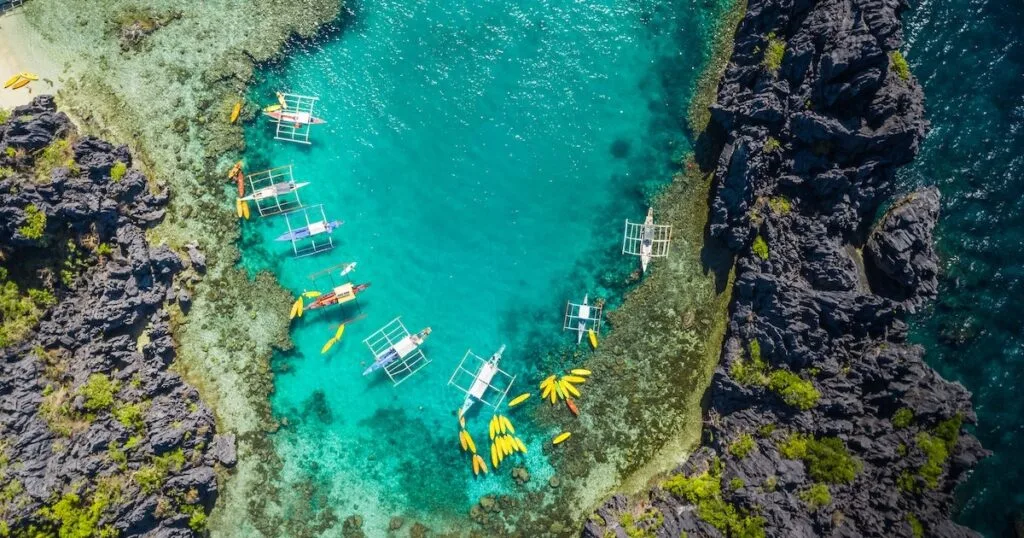
Exploring Small Lagoon by kayak is more intimate than kayaking Big Lagoon, and there’s no way that you will leave feeling like you didn’t have time to see and experience everything.
Because it’s so much smaller, you can really take the time to soak up the scenery and look for marine life too.
Coloured a deep sea green, the lagoon has several cliff jumping spots and deep areas suitable for swimming. There are a few small caves which indent the limestone cliffs.
2. Cadlao Island
Cadlao Island has yet another lagoon. This one is set on an impressive green island with a 609-metre hill. It’s also one of the largest islands that you’ll encounter while island hopping in El Nido.
Because Cadlao Island is so close to El Nido, adventurous tourists can kayak out to Cadlao Island directly from the town.
The island has limestone karsts and there are coral reefs at the end of the bay, but the lagoon is by far the prettiest place (and a great place to snorkel, too).
3. Pasandigan Beach, Nat Nat Beach and Paradise Beach
Pasandigan Beach, Nat Nat Beach, and Paradise Beach are three beautiful beaches with shallow waters and fab marine life. If you’ve been wanting to snorkel, these are the spots to do so.
Pasandigan Beach is particularly known for its turtles and isolated vibe. You can swim directly to the corals on Paradise Beach from the silkily soft sand.
4. Bukal Island
Bukal Island is just about the cherry on top for Tour D. It has calm, family-friendly shallows, ideal for relaxing. The island is smaller than Cadlao Island, and has a far wilder appeal.
The Best El Nido Tour for Luxury
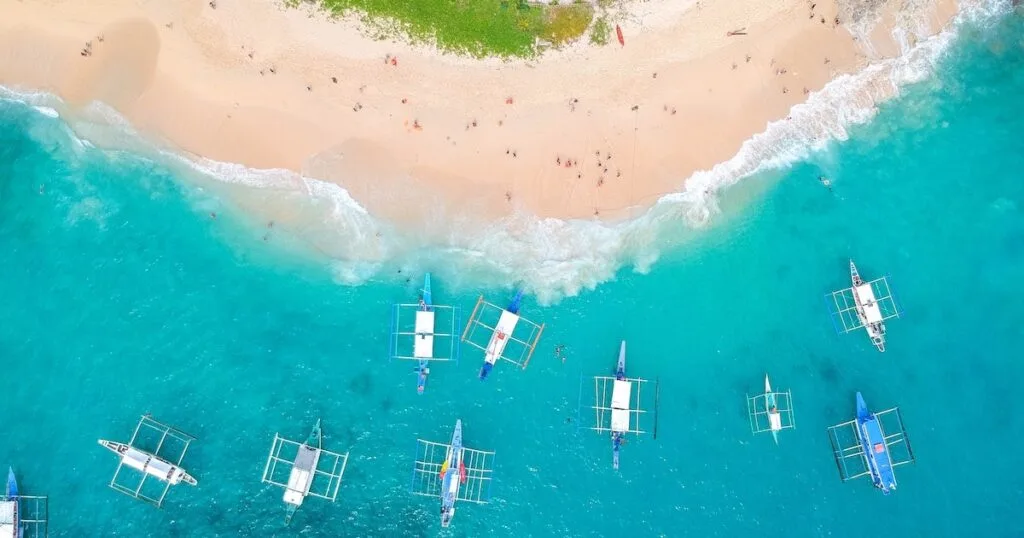
If you you’re looking for luxury, you’re in luck. There are a number of luxury boat tours that run from El Nido.
By far the most extensive luxury tour is the two-day private cruise on a 42-foot luxury sailing yacht.
The cruise involves sleeping in two private cabins on the yacht and visiting places far away from the typical tourist routes.
The yacht will take you to Malapacao Island for snorkelling, followed by a deserted sandbank at Lagen Island, and finally Dibuluan Island where the Survivor TV show was shot.
If you want a shorter luxury tour, you can take a day cruise on a private 43-foot Beneteau Oceanis 430 yacht. This tour also takes you away from the tourist sites to Dibuluan Island and Lagen Island.
There is another popular group luxury tour aboard a 50-foot sailing catamaran, which is more affordable because the boat can be shared with a minimum of six other guests. The catamaran visits some of the best spots on the Tour A, B, C, D routes.
The Best El Nido Tour Inland
Aside from island hopping, there are plenty of places to explore inland on the main island.
You can rent your own scooter to explore inland on your own but the easiest option is to take the Beyond El Nido jeepney tour.
Jeepneys are a traditional vehicle in the Philippines and an artistic symbol. The buses were converted from jeeps left behind by invaders in World War II.
This particular jeepney tour will take you to Lio Beach, a wide, windswept sandy bay with a long pier. I stayed in a resort next to the beach in 2018 and was blown away by the size of the beach.
The tour also passes through the El Nido countryside, taking you on a guided trek to the Bulalacao Waterfalls where you can swim or go cliff jumping.
The final stop is Napcan Beach for sunset with free unlimited cocktails at a beach bar. So, if you want to party, this is your chance. It’s a popular tour for the hostel crowd.
How to Avoid Crowds in El Nido
Crowds are the one thing that can turn the best El Nido tours into the worst. However, they are avoidable with a little planning.
1. Take a speedboat tour
By far the best way to beat the crowds is to take a speedboat tour. Speedboat tours travel at almost double the speed of the bangka boats used for the normal boat tours in El Nido.
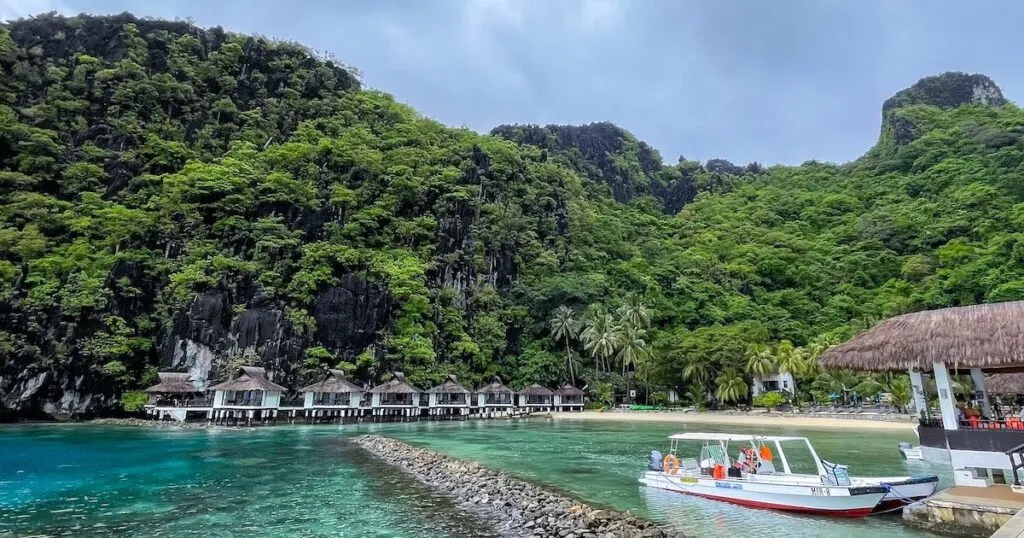
This gives you the chance to arrive at popular spots before other boats get there. You can also visit the destinations in a different order to the island tours when they are most likely to be less busy.
2. Depart early
Book a tour that departs early. Most tours leave by 8.45am. If you’re on a tour that’s leaving late or seems disorganised, you’re not on the best El Nido tour.
I find that tours booked online were far more prompt than tours booked through a hotel or hostel, as they depend upon positive online reviews for customers.
You can find tours on GetYourGuide or Klook.
3. Visit El Nido during the low season
Visiting El Nido during the low season is the biggest power move.
Accommodation is cheaper. Island tours are less crowded. It’s a win-win, as long as the weather forecast holds out.
Where to Stay in El Nido
One of the great things about El Nido is that it has a good range of value, mid-budget, and luxury places to stay.
There are two main backpacker hostels: Spin Designer Hostel and Frendz Hostel.
Spin Designer Hostel is by far the most bougie of the two, with activities like free margarita nights and free popcorn. Frendz Hostel is where I stayed. It has a rooftop pool with views over the town and sea. It’s one of the most social hostels I’ve stayed at.
If you’re on a luxury holiday, you absolutely must look at the private island resorts which surround El Nido. I was blown away by a visit to the Cauayan Island Resort and Spa in 2018. Matinloc Resort is also beautiful island resort.
In El Nido town, the most popular luxury resort is the El Nido Garden Resort.
If you want a mid-budget option instead, try the following hotels, but be aware that they book up fast:
- The Funny Lion
- SANSE Boutique Hotel
- H Hotel (vegetarian and vegan hotel)
You can also consider staying in the Las Cabañas Beach area, only a short tuk-tuk ride from the town proper. There are beachfront holiday apartments there.
Things to Do in El Nido
1. Get a massage.
There’s a massage parlour on the main road in El Nido called The Organic Spa El Nido, which honestly gives the best hilot massage I’ve had in the space of nearly two months in the Philippines.
2. Climb the Taraw Cliffs
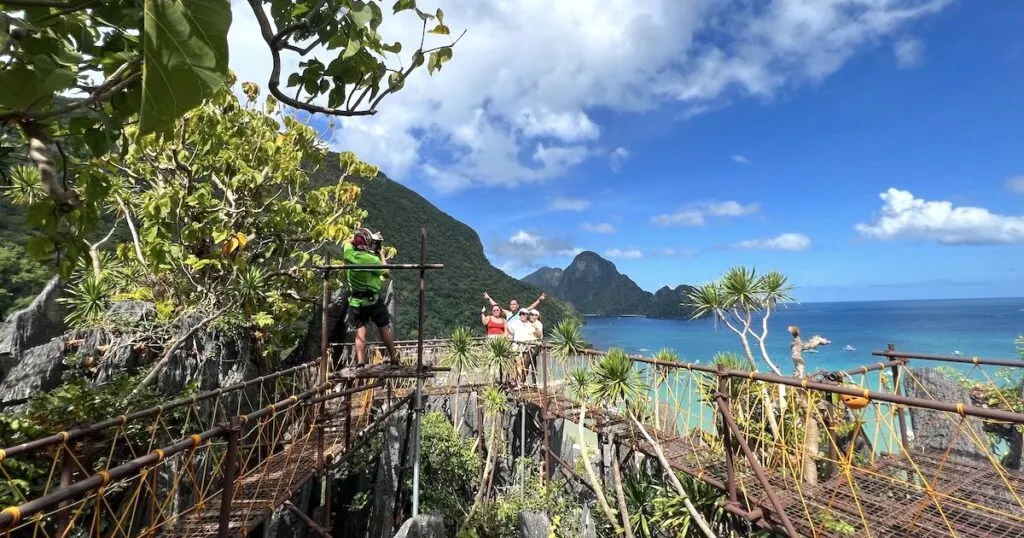
Before the canopy walk existed, people used to scramble up the Taraw Cliffs to get photos of the bay from the precarious limestone ledges. Some people still do, illegally I might say, as it has been banned.
Now, locals have erected a canopy walk (the Taraw Via Ferrata) consisting of boardwalks which will take you safely to the top of the cliffs in a harness.
I can’t really compare the health and safety standards to those in Australia or Britain, but it seems sturdy enough, and it’s a wonderful way to take in the views. Plus, the climb only takes 20 minutes.
You’ll need to book a ticket either at the office in town or online: get your Taraw Via Ferrata ticket.
3. Take the Las Cabañas Beach zipwire
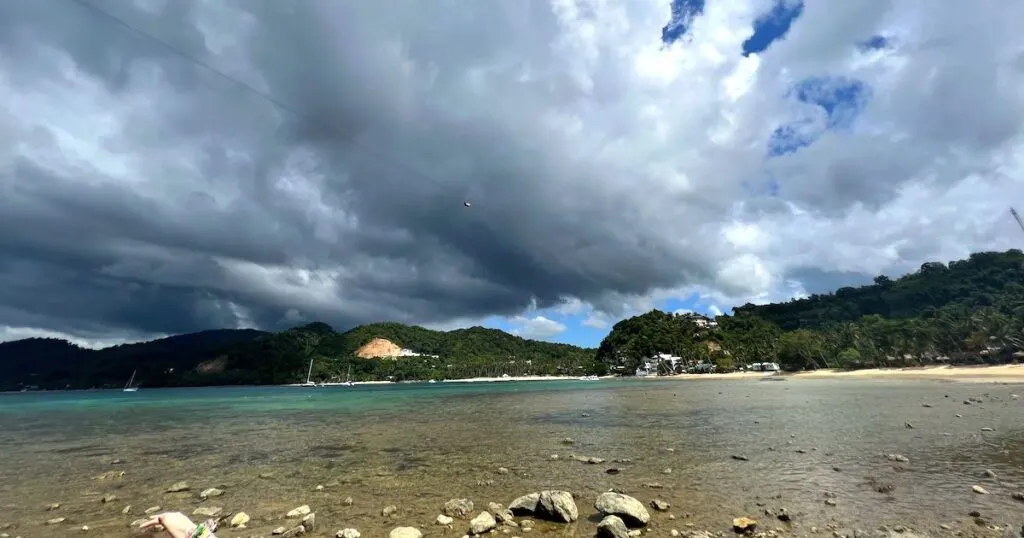
El Nido Beach isn’t suitable for a beach day because of all of the boats docked or coming and going.
The best place is Las Cabañas Beach, which is approximately a 20-minute tuk-tuk ride from the town.
The area is fairly built up. To reach the beach, you must walk through a small outdoor mall with a gym, bougie restaurants and coffee shops.
The beach is usually fairly empty, as aside from the residents of the small strip of holiday apartments alongside the beach, not many people visit from the town.
One of the best attractions at the beach is the zipwire, which travels from a slope over the beach to an islet adjoined to Las Cabañas by a sandbar.
To reach the zipwire, you’ll need to walk up a very steep hill or rent a scooter driver to drive you up there (it’s around 20 minutes’ walk from the mall).
4. Go waterfall trekking
The Bulalacao Waterfalls are part of the Beyond El Nido jeepney tour, but you can also rent a tricycle driver to take you there and wait for you for several hours. Otherwise, rent a scooter from the town.
There are two waterfalls – one big and one small. Both have swimming holes where you can take a dip. It’s a gorgeous two-hour hike through the jungle to and from the largest waterfall.
Where to Visit After El Nido
1. Napcan Beach
Napcan Beach can be visited on a day trip from El Nido, as I did. The four-kilometre beach is perhaps one of the best in Palawan, lined with palm trees.
The incredibly soft sand merges into very safe, shallow, and warm water, making it a great place to swim.
However, you may want to stay the night (or two) because Napcan Beach is best known for the Napcan Beach Glamping site, which is quickly turning into a Palawan rite of passage.
It’s so popular that it books up months in advance. No wonder why, as it is a pretty once-in-a-lifetime experience to stay in a luxury bell tent on a tropical beach surrounded by palm trees and with a beach sunset to look forward to every evening.
You can book a transfer to and from El Nido and Napcan Beach online.
2. Port Barton

Port Barton is sometimes overlooked on a Palawan itinerary. However, the small village and its peaceful beaches are a gentle reprieve after the lively tourist town of El Nido. It is a three-hour drive south of El Nido.
Port Barton is also an island-hopping destination.
If you didn’t get lucky enough to spot a turtle in El Nido, this might be your chance, as Port Barton island hopping tours visit Turtle Spot, where they are frequently spotted.
The reefs in Port Barton are less busy than those in El Nido, and thought to be of better quality.
3. Puerto Princesa
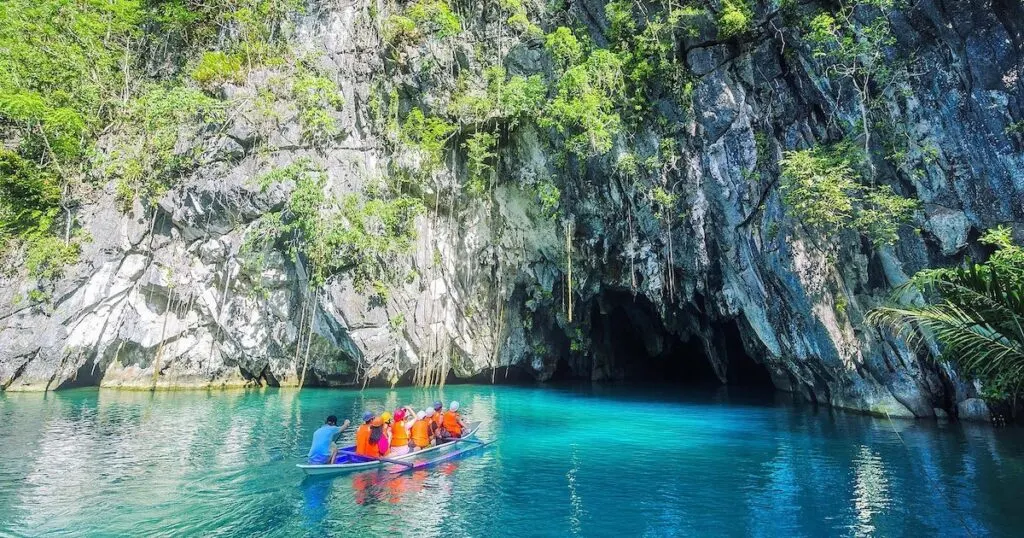
As Palawan’s capital city, Puerto Princesa is a place where you can see how everyday life operates in urban Palawan.
There aren’t too many tourist attractions around in the typical sense, but eating at local restaurants, visiting coffee shops, and experiencing the mall culture still guarantees a great time.
Puerto Princesa is the departure point for tours to the Puerto Princesa Subterranean Underground River, a UNESCO World Heritage Site and one of the most impressive places in Palawan.
I took this full-day tour of the Puerto Princesa Subterranean River from the city. Gliding into the 15-mile-long limestone karst underground river, with only the sound of fluttering bats and water dripping from the stalactites, is not something I will forget soon.
You can book a transfer to Puerto Princesa online if you need to.
FAQ
Tour A visits Big Lagoon, one of the most popular island hopping attractions in El Nido. Tour B visits mostly peaceful beaches. Meanwhile, Tour C is known for attractions such as secret beaches and Matinloc Shrine.
The most popular tours in El Nido are Tours A and C.
Tour C takes approximately eight hours.
The best season to visit El Nido is between November and March because the temperatures are manageable and there shouldn’t be much rain.
AUTHOR
Katie Treharne
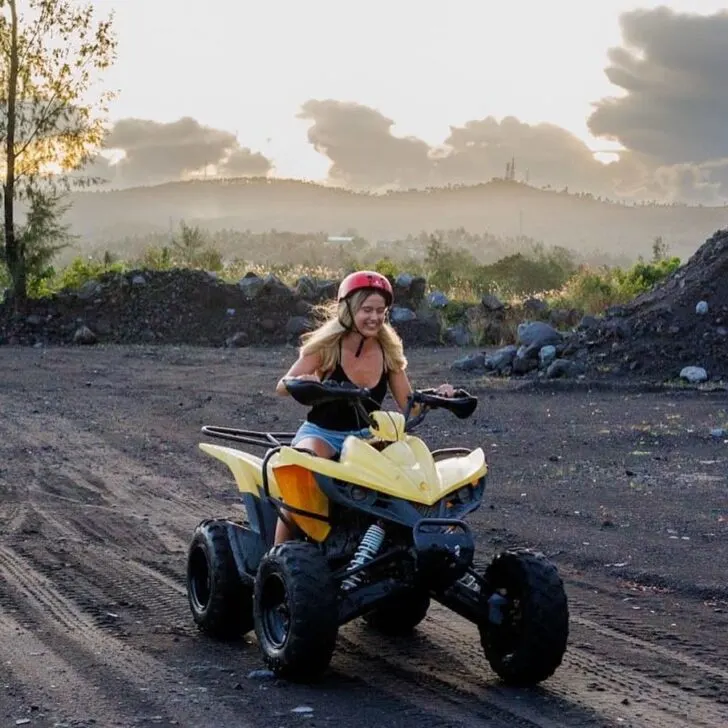
I’m Katie, the owner of Escape Artist Katie. I have been travel writing since 2018, including writing for luxury travel magazines and publications such as Wanderlust.
As well as being a digital nomad who works and lives abroad permanently, I’m a big advocate for offbeat travel and pushing yourself out of your comfort zone.
I hope you found my article useful – find out more about me here or keep up with my travels on Instagram.

